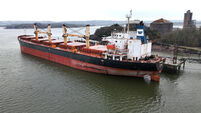Flight of fancy at lovely Saint-Exupéry
Born in 1900, Antoine de was a larger-than-life figure who wrote autobiographical novels.
His children’s novella, Le Petit Prince, appeared in 1943. Extraordinarily successful, it would be translated into countless languages. Over 80 million copies of The Little Prince were sold, making it one of the best-selling books of all time.
Saint-Exupéry was equally famous for his exploits as an airman and it’s appropriate than an airport should be named after him. He took up flying at the age of 21 and worked as an aerial postman, flying mostly between France and North Africa. In 1935, having been airborne for 19 hours attempting to break the Paris to Saigon flight-time record, he crash-landed in the Sahara. With no idea of their location and having little food and water, he and his navigator experienced delirium and hallucinations in the murderous heat. Miraculously, they were rescued by a Bedouin on a camel after four days wandering in the desert. In the plot of the Little Prince a young pilot is marooned in the desert, an idea which must have come from its author’s near-death experience. A fennec fox he encountered there, also appears in the story.
In July 1944, while on a reconnaissance mission for the Free French Forces, Saint-Exupéry’s plane disappeared over the Mediterranean. A body was found several days later, but it was never positively identified as his.
Airports, as the cliché has it, are all the same, bland places to be got through as quickly as possible. However, Lyon’s Saint-Exupéry is a notable exception; the train station there is a remarkable building, well worth visiting. There’s no difficulty finding it; the huge winged structure dominates the skyline and is immediately visible as your plane taxies in.
The Gare de Saint-Exupéry TGV station was designed by the Spanish architect Santiago Calatrava. His work is well known to Dubliners because the James Joyce and Samuel Beckett bridges, which span the Liffey, are his creations. Talking to architects, I get the impression that he is seen as something of a maverick among that profession. However, his bridges and buildings have always appealed to me and seeing his Lyon terminal two weeks ago was an experience. Like Saint-Exupéry who, despite being an adventurer and fighter à la Hemmingway, could still write a classic children’s book, Calatrava manages to bring together many disparate elements. His holistic, back-to-nature approach, combines engineering architecture and biology in what are essentially giant pieces of functional sculpture. Symbols abound and there are echoes of his fellow-countryman Antoni Gaudi. Most importantly, Calatrava’s creations seem to appeal to the public.
The airport train-station, on the TGV line between Paris and Marseille, was completed in 1994 at a cost 750 million francs, an enormous sum at the time. Resembling a giant bird rather than an aeroplane, this glass concrete and steel structure faces away from the airport terminal, the long kestrel-like tail serving as a conduit to the departure and arrivals areas. The falcon-like ‘bill’ curves downwards. Seen from the front, it resembles the head of a giant bee with the proboscis inserted in the ground, another aerial metaphor. Huge semi-transparent wings, ribbed like those of 1930’s biplanes, extend over the railway lines and platforms. Seen from the side, the great humped torso, in which the wings are embedded, recalls a stegosaurus or a giant ant-eater.
Walking the concourses, is like being inside the rib-cage of a whale, the glass structures above recalling the transparent tracery of dragonfly wings. Animal and plant references are everywhere but there are aviation ones too; the Star Wars ‘head’ recalls the cockpit of fighter jet and the long straight wings resemble runways. Is the vaulting of great gothic cathedrals also being evoked?
Lyon is renowned for its gastronomy. If you travel to the city by air, Calatrava’s creation offers a memorable sight-seeing ‘entrée’ or, better still, a ‘digestive’; allow a little extra time when departing, check the bags in for your flight and go savour this extraordinary building.
* www.rhonealpes-tourisme.com













